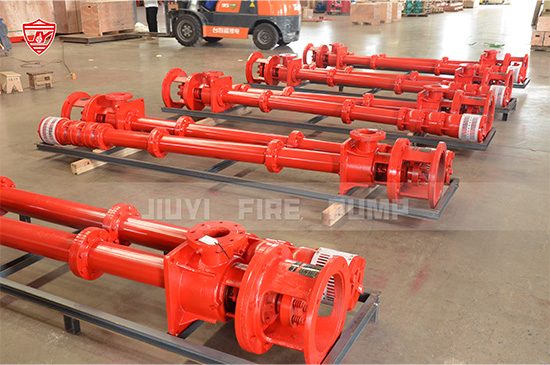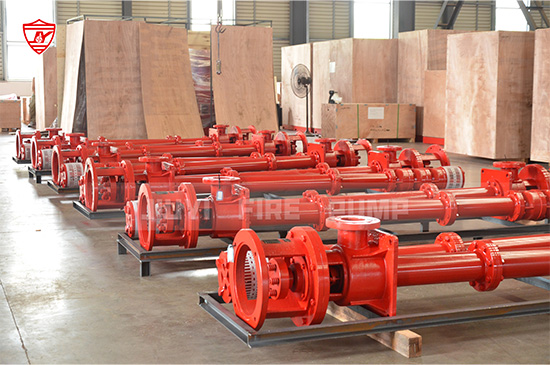When it comes to fire safety systems that draw from deep water sources—whether boreholes, deep sumps, rivers, lakes, or underground reservoirs—vertical turbine pumps stand out as the premier choice. These pumps combine exceptional efficiency, reliability, adaptability, and low maintenance—key advantages for manufacturers, system designers, installers, and end-users in the fire protection industry. In this article, we’ll explore in depth why vertical turbine pumps are especially suited for deep water applications in fire pump setups, examining hydraulic performance, construction benefits, installation flexibility, maintenance considerations, cost-efficiency, and compliance with industry standards.

One of the foremost strengths of vertical turbine pumps is their hydraulic efficiency across high vertical lifts. These pumps utilize multiple stages (impellers) to generate high pressure gradually and efficiently. For deep water reserves—often tens of feet below ground or water surfaces—this multistage design enables reliable suction and delivery.
Unlike some horizontal pumps, vertical turbines avoid cavitation issues because the pump suction lift is located at depth, and the vertical column reduces air entrainment risk. As a result, flow remains steady even when water levels drop—a critical feature during prolonged firefighting operations or drought-influenced conditions.
Moreover, vertical turbine pumps can be designed for specific head and flow requirements, optimizing efficiency curves right where the system operates, reducing energy consumption, which is particularly significant for always-ready fire protection systems.
Vertical turbine pumps are built for demanding, continuous-use environments: they feature rugged shaft lines, bearings, and sealed components designed to withstand debris, sediment, and variable supply conditions. The long drive shaft, supported by intermediate bearings, keeps the motor on the surface—protected from water intrusion—while the pumping elements remain submerged.
This separation of motor and pump allows for easier servicing and isolation of mechanical components in isolation from the driven equipment. It also automatically protects the motor from water-borne contaminants and ensures that the electrical equipment stays dry—bolstering long-term reliability.
Vertical turbine pumps offer a compact footprint compared to horizontal alternatives—especially valuable in constrained plant rooms or pump houses. Since the pump column extends downward into the water source, but the motor remains above ground, the layout occupies minimal floor space, while delivering powerful performance.
They also adapt readily to varying water levels. Adjustable column lengths and modular hardware enable the pump to be positioned optimally—even if the water depth changes seasonally. For fire pump installations in municipal or industrial applications, where flexibility and adaptability are vital, that modularity is a strong advantage.
Fire pump systems must be exceptionally reliable, and maintenance should be swift and minimally invasive. Vertical turbine pumps facilitate this with several design advantages:
Surface-mounted motor and coupling: Technicians can access and service mechanical seals, bearings, and couplings without having to drain suction wells or access submerged components.
Replaceable bowls and impellers: Wear components can be swapped with minimal disruption.
Column plug designs: Enable intermediate rod or shaft inspection without full pump disassembly.
These features reduce downtime and ensure that critical fire pump equipment remains operational—consistent with NFPA (National Fire Protection Association) priorities for redundancy and uptime.
Though initial costs may be higher than for simple horizontal or end-suction pumps, the total lifecycle cost of vertical turbine pumps is often lower. This is due to:
Lower maintenance labor and downtime costs—thanks to easy access and modular servicing.
High operating efficiency, reducing electricity consumption, especially significant at high heads.
Longer mean time between failures (MTBF), thanks to sealed submerged hydraulics and robust design.
For fire protection clients, minimizing energy and servicing expenses while maximizing reliability represents a compelling value proposition—and one that vertical turbine models typically deliver better than alternatives.
Fire pumps must meet stringent industry standards—such as NFPA 20 in the United States or equivalent codes elsewhere. Vertical turbine fire pumps are widely recognized and approved under these frameworks. They can be factory-tested for required performance, flow, and pressure in expensive yet standardized setups.
Their modular design also simplifies integration of features like jockey pumps, redundant drivers, or fire brigade connections, ensuring they meet national legal requirements and system performance expectations.
Whether drawing water from a deep well in a rural area or from rivers with fluctuating levels, vertical turbine pumps adapt gracefully:
Submergence flexibility: A few feet or tens of feet of water depth can be accommodated by adjusting the pump column length.
Foot-valve and suction protection options: Prevent backflow and sediment ingress, preserving hydraulic integrity.
Anti-vortex intake designs: For above-ground reservoirs, these reduce vortex formation and ensure reliable suction.
This makes vertical turbine pumps especially appropriate for remote firefighting installations—such as agricultural facilities, data centres in undeveloped regions, or wildfire preparedness systems—where water level stability can’t be guaranteed.
| Attribute | Vertical Turbine Pumps | Horizontal / End-Suction Pumps |
|---|---|---|
| Efficiency | High, especially at high heads | Lower at same head |
| Suction Lift | Excellent for deep sources (submerged bowls) | May require additional suction setup |
| Motor Protection | Motor stays above water, protected | Often exposed to wet environments |
| Footprint | Small surface footprint | Larger footprint, more floor space needed |
| Maintenance Access | Excellent—surface-mounted parts serviceable | May require more intrusive access |
| Flexibility | Modular, adapts to changing water depths | Limited adaptability |
| Lifecycle Costs | Lower (efficiency + maintenance) | Possibly higher over time |
| Fire Code Compliance | Well-established, factory-tested options | Varies—some configurations may need more work |
A municipal waterworks was upgrading its primary fire protection pump, drawing from a subterranean reservoir 40 feet deep. They replaced a horizontal pump (which struggled with suction lift and required a priming arrangement) with a vertical turbine pump configured with five stages.
Benefits observed:
Steady fire flow: The multistage pump provided reliable flow at 40 ft suction depth without priming.
Reduced maintenance time: Motor and coupling replacement could be done above grade—no need to enter the sump.
Energy savings: Transitioning from ~60 % to ~75 % pump efficiency reduced drive energy consumption by ~20 %.
Simplified installation: Smaller footprint saved retrofitting costs in the cramped pump room.
Assess water depth and head requirements
Determine static water level and required discharge head. This ensures correct stage selection and pump sizing.
Prioritize efficiency curves
Choose a pump model whose Best Efficiency Point (BEP) aligns with expected operating flow rates to minimize energy waste.
Model durability and materials
In abrasive or corrosive water, select hardened impellers and shafts, stainless or duplex materials for longevity.
Focus on serviceability
Confirm ease of access to wear components and that OEM provides modular spare parts and local support.
Verify code compliance
Ensure pump models are tested to NFPA 20 or applicable codes, with certified performance curves and test documentation.
Consider power-saving options
Variable frequency drives (VFDs) or optimized motor arrangements may lower operating costs, though fire pumps often require fixed speed per code.
Plan for variable water levels
Use adjustable column couplings or sektion rods to reposition intake depths as water sources fluctuate.

For fire safety applications requiring extraction from deep water sources, vertical turbine pumps are the standout option. Their multistage hydraulic efficiency, rugged submerged design, protected motor configuration, minimal footprint, modularity, and long-term reliability align perfectly with the demands of fire protection systems.
While horizontal or end-suction pumps might serve adequately in shallow or easily accessible water conditions, they fall short when dealing with high suction lifts, tight floor space, or fluctuating water levels. Investing in vertical turbine technology may cost more upfront—but the energy savings, reduced maintenance, and performance reliability make it a cost-effective and safety-focused decision across the lifecycle of the fire pump.
By carefully specifying vertical turbine pumps—matching head, flow, material durability, and service access—you ensure your fire water supply remains robust, code-compliant, and always ready when called upon.